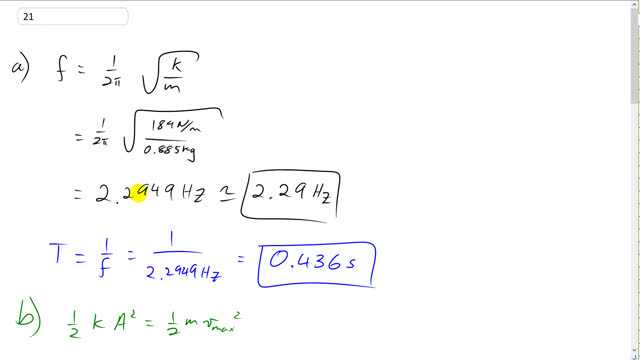
At t = 0, an 885-g mass at rest on the end of a horizontal spring (k = 184 N/m) is struck by a hammer which gives it an initial speed of 2.26 m/s. Determine
- the period and frequency of the motion,
- the amplitude,
- the maximum acceleration,
- the total energy, and
- the kinetic energy when x = 0.40A where A is the amplitude.

In order to watch this solution you need to have a subscription.
This is Giancoli Answers with Mr. Dychko. The frequency of this oscillator will be 1 over 2π times the square root of the spring constant divided by the mass. So, that's 1 over 2π times 184 newtons per meter divided by 0.85 kilograms which rounds to 2.29 hertz. Period is the reciprocal of frequency. So, that's 1 over 2.2949 hertz. And using the unrounded number there to avoid intermediate rounding error. And this gives 0.436 seconds for the period. For finding the amplitude we know v max because the hammer strikes the mass when it's at its equilibrium position. So, the speed that it imparts is going to be the maximum speed because that'll be the speed at equilibrium position which is the maximum speed. So, therefore we can say 1/2 k times A squared which is the total energy expressed in terms of amplitude is going to equal 1/2 m Vmax squared and we know everything in this equation except for A. So, we can solve for it and multiply both sides by 2 and divide both sides by k. And then take the square root of both sides and you get amplitude is square root mass over spring constant times v max so, a square root of 0.85 kilograms divided by 184 newtons per meter times 2.26 meters per second which gives an amplitude of 0.157 meters. And then for finding the maximum acceleration that'll happen when the mass is at its maximum displacement from equilibrium at which point it'll have a spring force equal to k times amplitude. And that'll be the only force on it and so it makes it the net force ma. And then divide both sides by m. And we have acceleration is a spring constant times amplitude over mass. That's 184 newtons per meter times 0.15674 meters divided by 0.85 kilograms which gives 32.6 meters per second squared. And then for the total energy, 1/2 K times A squared. So, that's 1/2 times spring constant, 184 newtons per meter times 0.15674 meters. And we square that amplitude and we found that amplitude up here before. And that gives 2.26 joules. To find the kinetic energy at this particular position, we know that the kinetic energy plus the potential energy equals the total energy. And we can take this to the right hand side by subtracting it from both sides and then substitute in 0.4 A for x. It's the point it's 40% of the amplitude at this position here. And that makes 1/2 ka squared A common factor between these 2 terms and which we can then factor out. So, 1/2 k A squared times 1 minus 0.4 squared will give us a kinetic energy. But this is a total energy that we found up here already, so we can substitute in to 0.2602 joules for that 1/2 k A squared. And that's times 1 minus 0.4 squared which gives 1.90 joules for the kinetic energy at that position.
This question is the answer for question 20 not 21.
Hi chaegyunkang, it looks like you're using the Global 7th Edition. Here's the identical solution for problem 20, as you say, in the Global edition: https://www.giancolianswers.com/giancoli-physics-7th-global-edition-sol…
Please navigate for solutions starting with the Global edition: https://www.giancolianswers.com/giancoli-physics-7th-global-edition-cha…
Best wishes,
Mr. Dychko
I did part A on my calculator and I came up with 22.64942355. How did you come up with 2.29Hz?
Thank you.